Define the term ‘potential energy’ of charge ‘q’ at a
distance V in an external electric field. (All India 2009)
Answer: It is defined as the amount of work done in bringing the charge from infinity
to its position in the system in the electric field of another charge without
acceleration. V = Er.
Question 7.
A hollow metal sphere of radius 5 cm is charged such that the potential on its
surface is 10 V. What is the potential at the centre of the sphere? (All India
2011)
Answer:
The electric field inside the shell is zero. This implies that potential is
constant inside the shell (as no work is done in moving a charge inside the
shell) and, therefore, equals its value at the surface, which is 10 V.
Question 8.
A hollow metal sphere of radius 10 cm is charged such that the potential on its
surface is 5 V. What is the potential at the centre of the sphere? (All India
2011)
Answer:
Hollow metal sphere behaves as an equipotential surface, so the potential at
its centre will be 5 V
Question 9.
Why must the electrostatic potential inside a hollow charged conductor be the
same at every point? (Comptt. All India 2012)
Answer:
Inside the hollow charged conductor, electric field is zero therefore no work
is done in moving a small test charge within the conductor. Hence electrostatic
potential inside a hollow charged conductor is same at every point.
Question 10.
What is the geometrical shape of equipotential surfaces due to a single
isolated charge? (Delhi 2013)
Answer:
Concentric spheres with a gap between them not being uniform as V ∝1r
Question 11.
For any charge configuration, equipotential surface through a point is normal to the electric field.” Justify. (Delhi 2014)
Answer:
Work done in moving a charge over an equipotential surface is zero, hence a point on it will be normal to the electric field.
W = FS cos θ ∴ cos θ = 0 or θ = 90
Question 12
The given graph shows variation of charge ‘q’ versus potential difference ‘V’ for two capacitors C1 and C2. Both the capacitors have same plate seperation but plate area of C2 is greater than that of C1. Which line (A or B) corresponds to C1 and why? (Comptt. All India 2014)
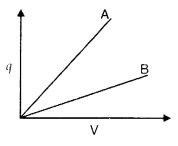
Answer:
Line B corresponds to C1
Reason: Since slope (qv) of ‘B’ is less than that of ‘A’
Question 13
Derive the expression for the electric potential at any point along the axial line of an electric dipole (Delhi 2008)
Question 14
Two point charges, q1 = 10 × 10-8C, q2 = -2 × 10-8C are seperated by a distance of 60 cm in air.
(i) Find at what distance from the 1st charge, q1 would the electric potential be zero.
(ii) Also calculate the electrostatic potential energy of the system. (All India 2008)
Answer:
(i) Given : q1 = 10 × 10-8C, q2 = -2 × 10-8C
AB = 60 cm = 0.60 = 0.6m
Let AP = x
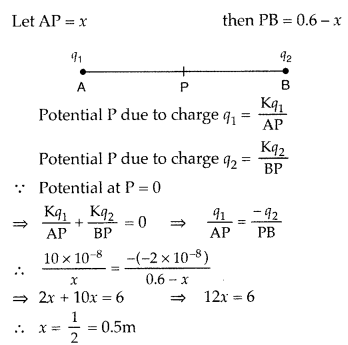
∴ Distance from first charge = 0.5 m = 50 cm.
(ii) Electrostatic energy of the system is
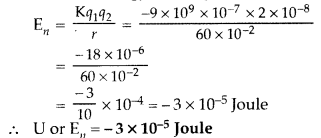
Question 15
Two point charges 20 x 10-6 C and -4 X 10-6 C are separated by a distance of 50 cm in air.
(i) Find the point on the line joining the charges, where the electric potential is zero.
(ii) Also find the electrostatic potential energy of the system. (All India 2008)
Answer:
(i) Here q1 = 20 × 10-6C, q2 = -4 × 10-6C
and AB = 50 cm = 0.50 m = 0.5 m Let AP = x then PB = 0.5 – x
Potential at P due to charge q1 = Kq1AP
Potential at P due to charge q2 = Kq2PB
Potential at P = 0 ⇒Kq1AP+Kq2PB=0
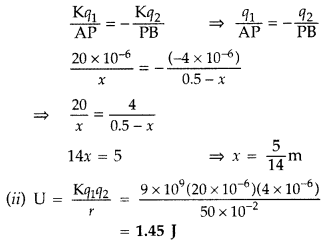
Question 16
Draw a plot showing the variation of
(i) electric field (E) and
(ii) electric potential
(iii) with distance r due to a point charge Q. (Delhi 2012)
Answer:
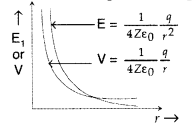
Question 17
The net capacitance of three identical capacitors in series is 1 pF. What will be their net capacitance if connected in parallel?
Find the ratio of energy stored in the two configurations if they are both connected to the same source. (All India 2011)
Answer:
Let C be the capacitance of a capacitor
Given : C1 = C2 = C3 = C When connected in series:
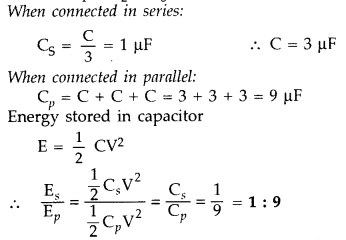
Question 18
An electric dipole of length 2 cm, when placed with its axis making an angle of 60° with a uniform electric field, experiences a torque of
8 √3 Nm. Calculate the potential energy of the dipole, if it has a charge of ± 4 nC. (Delhi 2014)
Answer:
1st method Given : 2a = 4 cm = 4 × 10-2 m, θ = 60°
τ = 4 × √3 Nm, q = ±8 nC = ±8 x 10-9 C
P.E. = |p| |E| cos θ, τ = |p| |E| sin θ
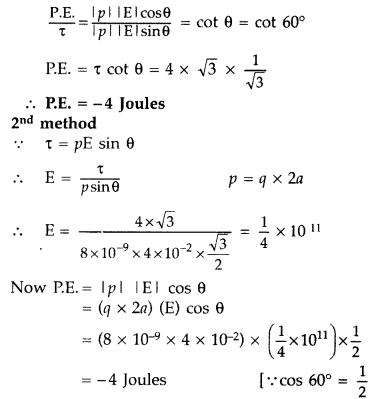
Question 19
A parallel plate capacitor is charged by a battery. After sometime the battery is disconnected and a dielectric slab with its thickness equal to the plate separation is inserted between the plates. How will
(i) the capacitance of the capacitor,
(ii) electric field between the plates and
(iii) the energy stored in the capacitor be affected? Justify your answer in each case.
Answer:
Let C be the capacitance and V be the potential difference.
The charge on the capacitor plates will then be Q = CV.
The electric field between the plates, E = Vd and the energy stored,

As the dielectric (K) is introduced after disconnecting the battery
We have the new values of charge, Q’ = Q Capacitance C’ = KC
Potential V’ = QKC=VK
(i) New capacitance is K times its original.













